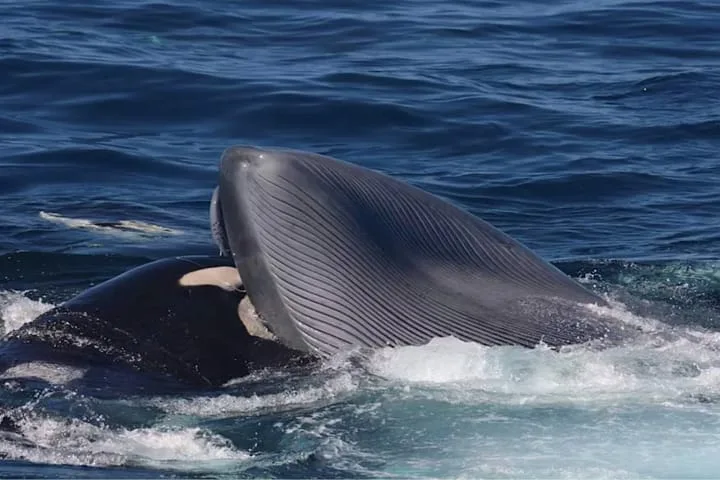

A killer whale goes for the tongue of the blue whale which is highly nutritious (Pics. Courtesy Twitter/@DrBecWellard)
<p>
<strong>As one of the top marine predators, scientists always wondered if the killer whales or orcas hunted the largest creature on the planet &ndash; the blue whales. Now for the first time, experts have been able to watch a pack of these killer whales stalking and devouring the blue whales, as per a report in sciencealert.com.</strong></p>
<p>
The details of the study have been published in Marine Mammal Science.</p>
<p>
The question which has been hounding scientists has been finally answered following three separate incidents in which killer whale packs attacked a blue whale on Western Australian coast. These have been recorded by marine scientists from Cetrec WA (Cetacean Research).</p>
<p>
<iframe allow="accelerometer; autoplay; clipboard-write; encrypted-media; gyroscope; picture-in-picture" allowfullscreen="" frameborder="0" height="315" src="https://www.youtube.com/embed/L7g7AVxOw5g" title="YouTube video player" width="560"></iframe></p>
<p>
In one of the instances, the orcas went for the mouth of the huge mammal to eat its tongue which is nutritionally rich.</p>
<p>
In their paper, the researchers wrote: <a href="https://www.sciencealert.com/australian-study-scientifically-documents-orcas-killing-blue-whales-in-world-first?utm_source=ScienceAlert+-+Daily+Email+Updates&amp;utm_campaign=73d78e97c1-MAILCHIMP_EMAIL_CAMPAIGN&amp;utm_medium=email&amp;utm_term=0_fe5632fb09-73d78e97c1-366100389">&quot;Here we provide the first documentation of killer whales</a> killing and eating blue whales: two individuals killed, 16 days apart in 2019, and a third in 2021. Notably, the first whale taken appeared to be a healthy adult.&quot;</p>
<p>
When the first killing took place, the researchers witnessed the whale which was 72-foot or 21.95 metres in length being attacked by a group of five orcas. Large pieces of skin and blubber had been torn from the body of the blue whale while a huge chunk of the dorsal fin had been ripped off.</p>
<p>
The relentless attack strategy saw the orcas attack from all sides &ndash; with three pushing the blue whale under water while two attacking its head. This group was joined by 50 more killer whales to eat the blue whale in six hours.</p>
<p>
<strong>Also read: <a href="https://www.indianarrative.com/science-news/scientists-puzzled-as-group-of-killer-whales-saves-life-of-humpback-rival-they-normally-hunt-as-prey-144784.html">Scientists puzzled as a group of killer whales saves life of humpback rival they normally hunt as prey</a></strong></p>
<p>
Following this incident, the next attack took place a few weeks later. In this case a blue whale calf which was 40-foot long (12 metres) was attacked by 25 orcas.</p>
<p>
The third and final attack that the study recorded was on a 45-foot (14 metre) long blue whale which was pursued for 90 minutes. The chase took place for 24 kilometres. Here again, the strategy was to push and ram the whale under the water while in the meantime, others in the pack targeted the creature&rsquo;s head and tongue. It took 50 of the orcas to devour the mammal following its death.</p>
<p>
<img alt="" src="https://www.indianarrative.com/upload/news/Killer_Whale_Attacking_Blue_Whale2_Twitter_DrBecWellard.webp" style="width: 720px; height: 480px;" /></p>
<p>
The study brought to light a surprising observation. In the earlier studies it was thought that the attacks by the orca pack to be successful had to be led by the biggest among them &ndash; and it was obviously thought to be a male as they could grow to 30 feet or 9 metres in length.</p>
<p>
This study, however, provided a major deviation from this thought. The documented killings showed that these hunts were led by female orcas. The study suggests that this aggressive drive to go for the kill among the females may be due to the responsibility of feeding their young ones.</p>
<p>
<strong>Also read: <a href="https://www.indianarrative.com/science-news/warming-waters-due-to-climate-change-proving-fatal-for-tiger-sharks-142633.html">Warming waters due to Climate Change proving fatal for Tiger Sharks</a></strong></p>
<p>
Commenting on this, the study&rsquo;s co-author Robert Pitman said: &quot;This is the biggest predation event on this planet: the biggest apex predator taking down the biggest prey.&rdquo;</p>
<p>
Pitman, who is a marine ecologist at Oregon State University&#39;s Marine Mammal Institute, told National Geographic:&nbsp; &ldquo;We don&#39;t have dinosaurs anymore, so for me as a whale biologist and a zoologist. It&#39;s an amazing thing.&quot;</p>
Prime Minister Narendra Modi interacted with members of the Indian diaspora here on Wednesday as…
The city of Hamburg in Germany is set to host the 11th edition of India…
The International Atomic Energy Agency (IAEA) has confirmed that two Iranian centrifuge production facilities, TESA…
The human rights department of the Baloch National Movement (BNM), Paank, has strongly condemned the…
In a major boost to India's coastal defence capabilities, the Indian Navy on Wednesday commissioned…
Volker Turk, the UN High Commissioner for Human Rights, on June 17 expressed concern over…